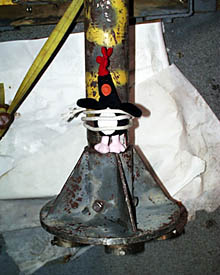|
|
TODAY'S WEATHER
This is what Mike Perfit and Dan Fornari found when they went to use "Mighty Mo" the rock corer tonight. Those naughty Pollywogs will pay for this! We cross the Equator in only a few days, and then the Honorable Shellbacks on King Neptune's Royal Ship RV Melville will rid the vessel of the Pollywogs. Their days are numbered!
Heading for the Galapagos Islands It was a night of dredging and rock coring for Mike Perfit, Dan Fornari and the student watch standers, who are learning the fine “art” of rock sampling. Teamwork is critical to the success of the cruise, and everyone is doing their job well, paying attention to details, and pitching in where work needs to be done, no matter whether it is their job or not. We have now sampled many of the volcanic features we identified from the DSL-120 sonar and Argo II data sets in this area near 1°40’N. While we have been able to do some preliminary analyses of the data on board, we have a lot of work to do when we get back to our labs. We have a few areas of very young lava which cover older seafloor structures and the axial trough on the East Pacific Rise crest in this area. Determining which could be the 1997 eruption detected by the Autonomous Hydrophone Array will have to wait for shore-based work. We also have some interesting data on the diffuse flow in the hydrothermal field that we discovered. After the biologists review the video data back on shore, they will give us more insight into whether the types and distribution of vent animals are consistent with a submarine volcanic eruption that happened three years ago. We will start our work in the third area, the Galapagos Rift near 97.5°W longitude in about a week. At that site, an eruption was detected by the Autonomous Hydrophone Array only 18 months ago. Late tonight ,we will start our transit to the Galapagos Islands. On the way we will be crossing the Equator -- a great event on a ship! Don’t miss King Neptune’s arrival on RV Melville, along with Davey Jones and the Royal Court. The celebrations will include getting rid of those scoundrels, the Pollywogs, and making them pay for the mischief they have caused! Everyone is looking forward to visiting the islands where Charles Darwin got many of his ideas about the evolution of species and natural selection. We have a transit of almost 800 nautical miles, and RV Melville will be going at a speed of about 12 knots. Try to estimate what day and time we will arrive in Puerto Ayora, on Santa Cruz island in the Galapagos Islands. We’ll keep you posted on our plans for a field trip on Santa Cruz island and to the Charles Darwin Research Station later this week, and our plans for a few days of dredging and mapping around the Galapagos Islands.
|
|||||||||||||||||||||||||||||||||||||||||||||||||||||||||||||||||||||||||||||||||||||||||||||||||||||||||||||||||||||||||||||||||||||||||||||||||||||||||||||||||||
© 2010 Dive and Discover™. Dive and Discover™ is a registered trademark of
Woods
Hole Oceanographic Institution




